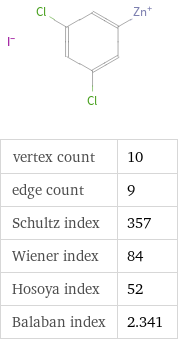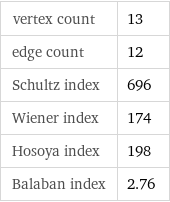Input interpretation

3, 5-dichlorophenylzinc iodide
Basic properties
![molar mass | 338.3 g/mol formula | C_6H_3Cl_2IZn empirical formula | I_Cl_2C_6Zn_H_3 SMILES identifier | C1=C(C=C(C=C1Cl)[Zn+])Cl.[I-] InChI identifier | InChI=1/C6H3Cl2.HI.Zn/c7-5-2-1-3-6(8)4-5;;/h2-4H;1H;/q;;+1/p-1/fC6H3Cl2.I.Zn/h;1h;/q;-1;m InChI key | KMIGCYCUVSVKEC-UHFFFAOYSA-M](../image_source/4b147a960ef7092dfc764048d264d0e2.png)
molar mass | 338.3 g/mol formula | C_6H_3Cl_2IZn empirical formula | I_Cl_2C_6Zn_H_3 SMILES identifier | C1=C(C=C(C=C1Cl)[Zn+])Cl.[I-] InChI identifier | InChI=1/C6H3Cl2.HI.Zn/c7-5-2-1-3-6(8)4-5;;/h2-4H;1H;/q;;+1/p-1/fC6H3Cl2.I.Zn/h;1h;/q;-1;m InChI key | KMIGCYCUVSVKEC-UHFFFAOYSA-M
Structure diagram

vertex count | 10 edge count | 9 Schultz index | 357 Wiener index | 84 Hosoya index | 52 Balaban index | 2.341
Quantitative molecular descriptors

longest chain length | 5 atoms longest straight chain length | 0 atoms longest aliphatic chain length | 0 atoms aromatic atom count | 6 atoms H-bond acceptor count | 0 atoms H-bond donor count | 0 atoms
Elemental composition

Find the elemental composition for 3, 5-dichlorophenylzinc iodide in terms of the atom and mass percents: atom percent = N_i/N_atoms × 100% mass percent = (N_im_i)/m × 100% Plan: • Write the chemical formula and gather atomic masses from the periodic table. • Determine values for N_i, m_i, N_atoms and m using these items. • Finally, compute the percents and check the results. Write the chemical formula: C_6H_3Cl_2IZn Use the chemical formula to count the number of atoms, N_i, for each element and find the total number of atoms, N_atoms, per molecule: | number of atoms I (iodine) | 1 Cl (chlorine) | 2 C (carbon) | 6 Zn (zinc) | 1 H (hydrogen) | 3 N_atoms = 1 + 2 + 6 + 1 + 3 = 13 Divide each N_i by N_atoms to calculate atom fractions. Then use the property that atom fractions must sum to one to check the work: | number of atoms | atom fraction I (iodine) | 1 | 1/13 Cl (chlorine) | 2 | 2/13 C (carbon) | 6 | 6/13 Zn (zinc) | 1 | 1/13 H (hydrogen) | 3 | 3/13 Check: 1/13 + 2/13 + 6/13 + 1/13 + 3/13 = 1 Compute atom percents using the atom fractions: | number of atoms | atom percent I (iodine) | 1 | 1/13 × 100% = 7.69% Cl (chlorine) | 2 | 2/13 × 100% = 15.4% C (carbon) | 6 | 6/13 × 100% = 46.2% Zn (zinc) | 1 | 1/13 × 100% = 7.69% H (hydrogen) | 3 | 3/13 × 100% = 23.1% Look up the atomic mass, m_i, in unified atomic mass units, u, for each element in the periodic table: | number of atoms | atom percent | atomic mass/u I (iodine) | 1 | 7.69% | 126.90447 Cl (chlorine) | 2 | 15.4% | 35.45 C (carbon) | 6 | 46.2% | 12.011 Zn (zinc) | 1 | 7.69% | 65.38 H (hydrogen) | 3 | 23.1% | 1.008 Multiply N_i by m_i to compute the mass for each element. Then sum those values to compute the molecular mass, m: | number of atoms | atom percent | atomic mass/u | mass/u I (iodine) | 1 | 7.69% | 126.90447 | 1 × 126.90447 = 126.90447 Cl (chlorine) | 2 | 15.4% | 35.45 | 2 × 35.45 = 70.90 C (carbon) | 6 | 46.2% | 12.011 | 6 × 12.011 = 72.066 Zn (zinc) | 1 | 7.69% | 65.38 | 1 × 65.38 = 65.38 H (hydrogen) | 3 | 23.1% | 1.008 | 3 × 1.008 = 3.024 m = 126.90447 u + 70.90 u + 72.066 u + 65.38 u + 3.024 u = 338.27447 u Divide the mass for each element by m to calculate mass fractions. Then use the property that mass fractions must sum to one to check the work: | number of atoms | atom percent | mass fraction I (iodine) | 1 | 7.69% | 126.90447/338.27447 Cl (chlorine) | 2 | 15.4% | 70.90/338.27447 C (carbon) | 6 | 46.2% | 72.066/338.27447 Zn (zinc) | 1 | 7.69% | 65.38/338.27447 H (hydrogen) | 3 | 23.1% | 3.024/338.27447 Check: 126.90447/338.27447 + 70.90/338.27447 + 72.066/338.27447 + 65.38/338.27447 + 3.024/338.27447 = 1 Compute mass percents using the mass fractions: Answer: | | | number of atoms | atom percent | mass percent I (iodine) | 1 | 7.69% | 126.90447/338.27447 × 100% = 37.52% Cl (chlorine) | 2 | 15.4% | 70.90/338.27447 × 100% = 20.96% C (carbon) | 6 | 46.2% | 72.066/338.27447 × 100% = 21.30% Zn (zinc) | 1 | 7.69% | 65.38/338.27447 × 100% = 19.33% H (hydrogen) | 3 | 23.1% | 3.024/338.27447 × 100% = 0.8939%
Elemental oxidation states

The first step in finding the oxidation states (or oxidation numbers) in 3, 5-dichlorophenylzinc iodide is to draw the structure diagram. Next set every oxidation number equal to the atom's formal charge: In 3, 5-dichlorophenylzinc iodide hydrogen is not bonded to a metal with lower electronegativity, so it will have an oxidation state of +1. Any element bonded to hydrogen gains the bonding electrons, decreasing their oxidation state by 1 for every bond: With hydrogen out of the way, look at the remaining bonds. There are 2 carbon-chlorine bonds, 1 carbon-zinc bond, and 6 carbon-carbon bonds. For each of these bonds, assign the bonding electrons to the most electronegative element. First examine the carbon-chlorine bonds: element | electronegativity (Pauling scale) | C | 2.55 | Cl | 3.16 | | | Since chlorine is more electronegative than carbon, the electrons in these bonds will go to chlorine. Decrease the oxidation number for chlorine in every highlighted bond (by 1 for single bonds, 2 for double bonds, and 3 for triple bonds), and increase the oxidation number for carbon accordingly: Next look at the carbon-zinc bond: element | electronegativity (Pauling scale) | C | 2.55 | Zn | 1.65 | | | Since carbon is more electronegative than zinc, the electrons in this bond will go to carbon: Next look at the carbon-carbon bonds: element | electronegativity (Pauling scale) | C | 2.55 | C | 2.55 | | | Since these elements are the same the bonding electrons are shared equally, and there is no change to the oxidation states: Now summarize the results: Answer: | | oxidation state | element | count -1 | C (carbon) | 4 | Cl (chlorine) | 2 | I (iodine) | 1 +1 | C (carbon) | 2 | H (hydrogen) | 3 +2 | Zn (zinc) | 1
Topological indices

vertex count | 13 edge count | 12 Schultz index | 696 Wiener index | 174 Hosoya index | 198 Balaban index | 2.76